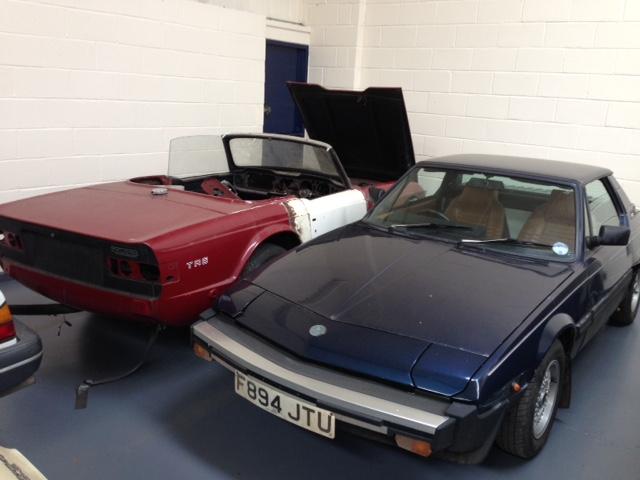Old cars, like old bones, don’t much like winter. It’s cold, wet, icy and generally not that pleasant. Classic cars like to be off the road and in a garage, preferably heated.
The reasons will be obvious to anyone who has persevered and driven their classic car through the winter. Old cars have erratic heaters, and they lack ABS and traction control. They don’t have electronic ignition, they mist up at the earliest opportunity, and they rust. Back in the 60s and 70s when these cars were new, their first owners thought nothing of wrapping the radiator in tin foil to keep the frost at bay, but that’s a long way from reality for today’s motorists!
 Of course, on or about the day when temperatures dip into single figures, every classic car-related blog, magazine and self-appointed pundit rushes out their annual list of advice on laying up your car. The Great Escape Cars list is a little different because our cars work for a living, so we have to follow the advice we give.
Of course, on or about the day when temperatures dip into single figures, every classic car-related blog, magazine and self-appointed pundit rushes out their annual list of advice on laying up your car. The Great Escape Cars list is a little different because our cars work for a living, so we have to follow the advice we give.
Here is our list of top tips for helping your classic car survive the winter months. It isn’t exhaustive but covers the main, simple and cost-effective ways to help your car survive winter.
Tip 1: Keep Your Classic Car Dry
Damp is a classic car killer, and eradicating it is a full time job. Dampness causes rust, deteriorates electrics, eats interiors and worms its way everywhere to often catastrophic effect. If you are garaging your car, consider investing in an indoor Carcoon, a superb and inexpensive way to solve the damp problem. Carcoon is a must if stored outside. If you can’t stretch to a Carcoon, ensure the storage area is waterproof and that air can circulate – this will help minimise dampness. Where possible leave a window open or a small gap under the doors to allow air to circulate.
Take care if you intend to put a cover on your car. The cover must be breathable and soft so that the moisture in the air does not get stuck between the car and the cover. It only takes a few months under a poor quality car cover to cause microblistering in the paint – which will be expensive to fix. If the garage is dry and relatively dust free a cover may not be necessary.

If you don’t have a garage seriously consider finding one – the money it costs will be less than the cost of repairing your deteriorating car. But if that simply isn’t possible make sure that the car is covered with a breathable, waterproof car cover .
Lastly, open the windows and air vents part way to enable air to circulate throughout the car.
Tip 2: Maintain Your Car’s Battery
During winter batteries suffer in the cold weather, and due to lack of use. There are two schools of thought with them. One is to use a trickle charger that keeps the battery topped up – the downside, say some, is that the battery is weakened by this process. Alternatively disconnect the battery from the car. The battery may drain but at a slower rate. We personally recommend a trickle charger.
Tip 3: Use Your Car!
 Using your classic in the winter may seem like a mad idea. Think of the salt, the damp, the mud, the snow! Certainly those are issues, but your car needs to be started and run regularly and the components exercised – without this seals dry out, parts seize up, tyres flat-spot and ancillaries give up the ghost. It is not wise to simply start it up and leave it running – this causes excessive engine wear and the car needs to move to be properly exercised.
Using your classic in the winter may seem like a mad idea. Think of the salt, the damp, the mud, the snow! Certainly those are issues, but your car needs to be started and run regularly and the components exercised – without this seals dry out, parts seize up, tyres flat-spot and ancillaries give up the ghost. It is not wise to simply start it up and leave it running – this causes excessive engine wear and the car needs to move to be properly exercised.
Find a suitable dry day and salt-free roads and give your car a 15-20 minute run every couple of weeks. At the end of the drive fully jet wash the bodywork and underside then dry off. The potential risk of deterioration to the bodywork is, we think, worth the pay-off in terms of mechanical deterioration and general reliability.
Tip 4: Underseal Your Car
A few pounds spent undersealing your car, or even having the cavities wax injected will pay dividends over the winter by protecting the hard-to-reach rust traps. I had my Alfa Spider wax injected for £120 7 years ago and it remains utterly rust free despite being used year-round over high mileages.
Tip 5: Keep Your Car Clean
Dust is a silent killer of paint, causing discolouration over time and scratches. Before you lay up your car for winter, thoroughly valet it. Apply a good polish to protect the paintwork and jet wash the underside, paying particular attention to sills and wheel arch lips.
Tip 6: Get The Antifreeze Mixture Right
The cheapest way to kill your car is to have a weak or non-existent antifreeze mix. The challenge for a stored car, is not to risk freezing inside the engine. Without the correct mix of antifreeze and water the latter will quickly corrode everything it touches inside your engine. We recommend a minimum 30:70 or ideally 50:50 mix.

Tip 7: Pump Up The Tyres
When a car is left standing for a long period of time, tyres can flat spot and deteriorate if the pressures are too low. As well as exercising the car it is a good idea to pump the tyres up beyond the normal recommended level and continue to monitor levels to avoid flat spotting.
When you recover your car from storage and put it back on the road, ensure that your tyres remain road legal and do not have any bulges or cracks in the sidewalls.
Tip 8: Release The Handbrake
When we store our cars we leave the handbrake off and put manual cars in gear. For automatics, we put the car in neutral and use chocks to stop it moving. Applying the handbrake and leaving it on for a prolonged period will very likely result in seized brakes when you come to move it.
Tip 9: Fill Your Car’s Tank
It is very tempting to store your car with minimal fuel. However, an empty fuel tank can develop condensation which can lead to rust. By filling the tank you avoid this problem. When storing your car with a full tank it is a sensible precaution to put a fire extinguisher nearby.
Tip 10: Grease Your Car’s Chrome
If your car is stored in a dry place, then the chrome and trim should be fine without further attention. However, some owners apply Vaseline or grease to chrome trim to prevent pitting. It is a sensible – if messy precaution.
The list of recommended tasks are a cheap and simple way to maintain your car’s condition.

